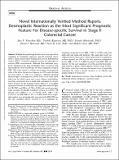Files in this item
Novel internationally verified method reports desmoplastic reaction as the most significant prognostic feature for disease-specific survival in stage II colorectal cancer
Item metadata
| dc.contributor.author | Nearchou, Ines P. | |
| dc.contributor.author | Kajiwara, Yoshiki | |
| dc.contributor.author | Mochizuki, Satsuki | |
| dc.contributor.author | Harrison, David James | |
| dc.contributor.author | Caie, Peter David | |
| dc.contributor.author | Ueno, Hideki | |
| dc.date.accessioned | 2019-06-26T16:30:01Z | |
| dc.date.available | 2019-06-26T16:30:01Z | |
| dc.date.issued | 2019-09 | |
| dc.identifier | 258966620 | |
| dc.identifier | 982535a8-7ad4-4baa-a1a7-3cc8ee2439e9 | |
| dc.identifier | 85067363190 | |
| dc.identifier | 000484342500009 | |
| dc.identifier.citation | Nearchou , I P , Kajiwara , Y , Mochizuki , S , Harrison , D J , Caie , P D & Ueno , H 2019 , ' Novel internationally verified method reports desmoplastic reaction as the most significant prognostic feature for disease-specific survival in stage II colorectal cancer ' , American Journal of Surgical Pathology , vol. 43 , no. 9 , pp. 1239-1248 . https://doi.org/10.1097/PAS.0000000000001304 | en |
| dc.identifier.issn | 0147-5185 | |
| dc.identifier.other | ORCID: /0000-0002-0031-9850/work/60196550 | |
| dc.identifier.other | ORCID: /0000-0001-9041-9988/work/64034231 | |
| dc.identifier.other | ORCID: /0000-0002-1863-5413/work/75610528 | |
| dc.identifier.uri | https://hdl.handle.net/10023/17978 | |
| dc.description | Funding: Medical Research Scotland and the Japan Society for the Promotion of Science. | en |
| dc.description.abstract | Multiple histopathologic features have been reported as candidates for predicting aggressive stage II colorectal cancer (CRC). These include tumor budding (TB), poorly differentiated clusters (PDC), Crohn-like lymphoid reaction and desmoplastic reaction (DR) categorization. Although their individual prognostic significance has been established, their association with disease-specific survival (DSS) has not been compared in stage II CRC. This study aimed to evaluate and compare the prognostic value of the above features in a Japanese (n=283) and a Scottish (n=163) cohort, as well as to compare 2 different reporting methodologies: analyzing each feature from across every tissue slide from the whole tumor and a more efficient methodology reporting each feature from a single slide containing the deepest tumor invasion. In the Japanese cohort, there was an excellent agreement between the multi-slide and single-slide methodologies for TB, PDC, and DR (κ=0.798 to 0.898) and a good agreement when assessing Crohn-like lymphoid reaction (κ=0.616). TB (hazard ratio [HR]=1.773; P=0.016), PDC (HR=1.706; P=0.028), and DR (HR=2.982; P<0.001) based on the single-slide method were all significantly associated with DSS. DR was the only candidate feature reported to be a significant independent prognostic factor (HR=2.982; P<0.001) with both multi-slide and single-slide methods. The single-slide result was verified in the Scottish cohort, where multivariate Cox regression analysis reported that DR was the only significant independent feature (HR=1.778; P=0.002) associated with DSS. DR was shown to be the most significant of all the analyzed histopathologic features to predict disease-specific death in stage II CRC. We further show that analyzing the features from a single-slide containing the tumor’s deepest invasion is an efficient and quicker method of evaluation. | |
| dc.format.extent | 10 | |
| dc.format.extent | 537248 | |
| dc.language.iso | eng | |
| dc.relation.ispartof | American Journal of Surgical Pathology | en |
| dc.subject | Desmoplastic reaction | en |
| dc.subject | Tumour budding | en |
| dc.subject | Poorly differentiated clusters | en |
| dc.subject | Prognosis | en |
| dc.subject | Colorectal cancer | en |
| dc.subject | RB Pathology | en |
| dc.subject | RC0254 Neoplasms. Tumors. Oncology (including Cancer) | en |
| dc.subject | RD Surgery | en |
| dc.subject | NDAS | en |
| dc.subject | SDG 3 - Good Health and Well-being | en |
| dc.subject.lcc | RB | en |
| dc.subject.lcc | RC0254 | en |
| dc.subject.lcc | RD | en |
| dc.title | Novel internationally verified method reports desmoplastic reaction as the most significant prognostic feature for disease-specific survival in stage II colorectal cancer | en |
| dc.type | Journal article | en |
| dc.contributor.institution | University of St Andrews. School of Medicine | en |
| dc.contributor.institution | University of St Andrews. Sir James Mackenzie Institute for Early Diagnosis | en |
| dc.contributor.institution | University of St Andrews. Cellular Medicine Division | en |
| dc.identifier.doi | https://doi.org/10.1097/PAS.0000000000001304 | |
| dc.description.status | Peer reviewed | en |
This item appears in the following Collection(s)
Items in the St Andrews Research Repository are protected by copyright, with all rights reserved, unless otherwise indicated.

